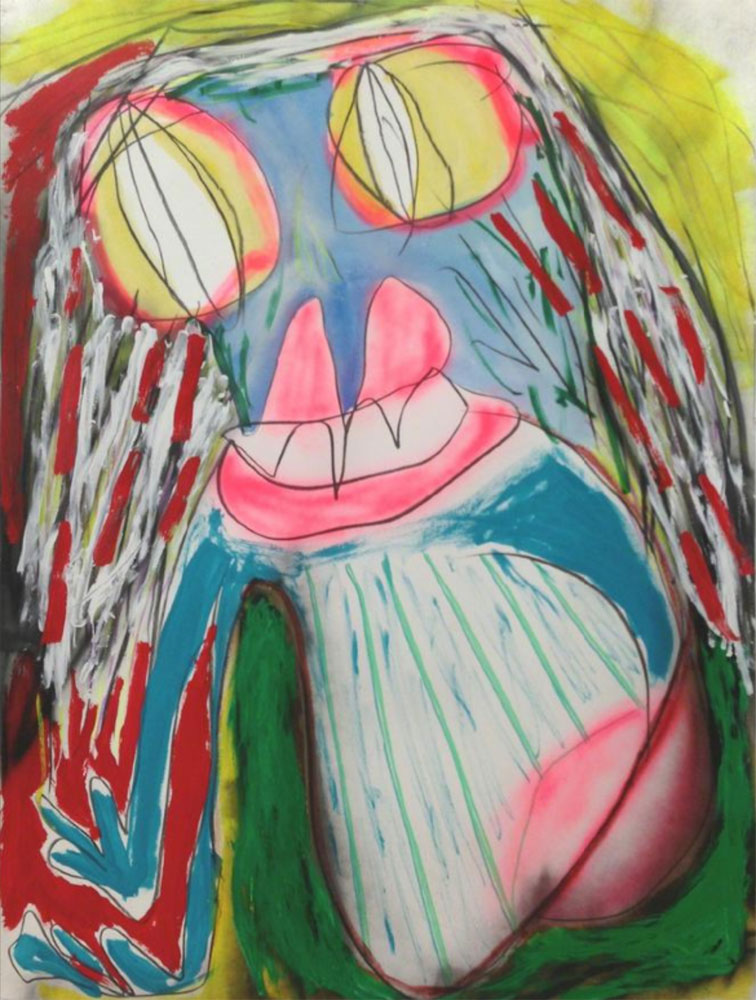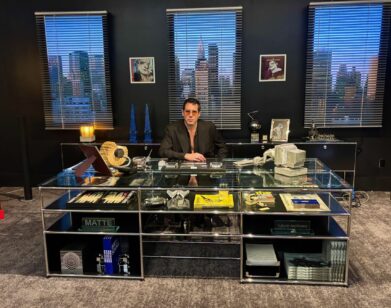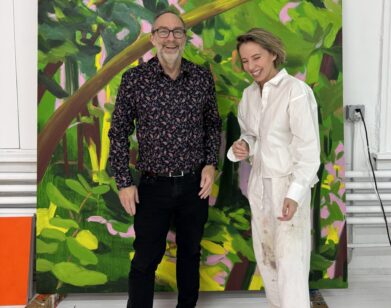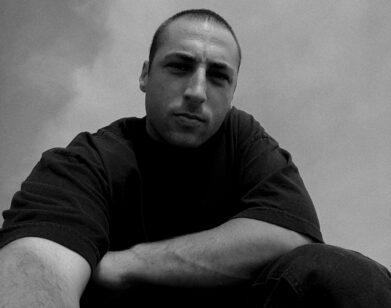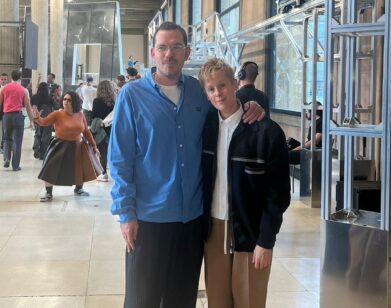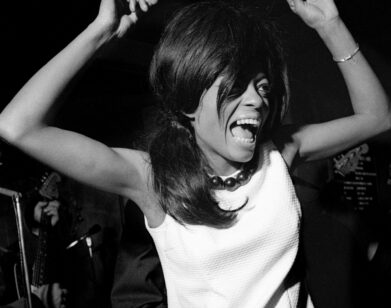Away from Abstraction
ANTHONY MILLER IN NEW YORK, MAY 2015. PORTRAIT BY FRANK SUN.
The long history of abstract painting began as a revolutionary concept in the early 20th century, but recently reached a plateau that lacks much thought, let alone pioneering ideas. Mostly in the form of process-based abstraction, or “zombie formalism,” the term made ubiquitous by Jerry Saltz, the style at best can be described as decorative, and at worst, derivative, driving a uniformity that appeals to market rather than soul.
The Brooklyn-based artist Anthony Miler, who graduated in 2008 from City College of New York’s MFA program, was once part of the herd, motivated by critical theory and a fondness for Abstract Expressionism of the late 1940s and ’50s. But he quickly felt drained. “I didn’t have any emotional approach to [painting], and I felt it was kind of lifeless,” he says. “It was good for apartments in Manhattan, but it felt like I ceased being human.”
In the years following graduation, Miler experimented with other styles, eventually destroying his older works. His new path took him to toward an aggressive, nonrepresentational style of figure painting, often rendered in frenzied graphite scribbles on large-scale, raw canvases.
People took notice of the artist’s shift, and last year, Miler, now 32, had his first solo show in New York with ART 3 in Brooklyn. At NADA’s art fair this year, the gallery gave him a solo booth, and rather than settling for another static format, Miler will display three different paintings each day, for the four days of the fair, totaling twelve works in all. This action is meant to address both the short duration and the high visibility of the art fair—a sales-driven format that has burgeoned in the art world over the last several years, that coincidentally (or not) parallels the influx of process-based abstraction.
Earlier this week, before NADA’s opening, we spoke to Miler over the phone.
RACHEL SMALL: I’d love to hear about your background.
ANTHONY MILER: I grew up in Michigan, a little town called Adrian, near Ann Arbor. I wasn’t one of those kids taken to museums with their parents. I just drew a lot, mostly comics, [and] kids at school said I was good at it. Then I had to figure out what to do for college, an art teacher said, “Apply for these scholarships,” and I did. Then a school gave me money to go to school so I figured let’s go that way. That was where I [discovered] art and culture.
Early on, I was way more into Abstract Expressionism. It’s so anachronistic, but something about the visceral qualities of it [appealed to me]. I feel like a lot of artists, at least my generation, have started there and then moved on. It’s interesting that it is also an American thing; it’s where modern art in America begins. [From there] I continued to do process-based abstraction. I was doing it pretty rigorously, coming at it from a super conceptual approach where every single thing was decided and meant something. But in the end, the work was supposed to dissolve in front of your eyes and be meaningless. Everything was intentionally contradicting. People didn’t have an approach to it. It was completely devoid of tactile reality. So I swung the pendulum back. It was a gradual process…because I had a lot of theoretical and historical investment in the cold abstraction I was doing. [Finally,] I destroyed most of the [old] stuff and kept a few things just for my records.
SMALL: Does your work now have any trace of what you destroyed?
MILER: I think that there’s still an abrasive politics to it, and that’s something that I feel is like a long, careful conversation. But there’s definitely a politics to it that carries some subversion through action or aggressive action, specifically aggressive action with the body. It’s an action of drawing; it’s less sitting there and rendering slowly with brushes. That’s very bodily. It’s not [just] in the wrist; it’s in the arm and the whole body.
SMALL: How long does it take you to make the large-scale drawings? Do you make studies?
MILER: Some have some studies that end up looking like different pieces all together. Sometimes I just have an idea and go with it and see where that leads. There’s not a hard and fast rule. I think that that’s part of a subconscious decision to avoid getting back into that theoretical trap [of the process based abstraction] work that I used to make. I’m trying to avoid a rigid system where work freezes up and becomes lifeless. People end up painting the same picture over and over. As far as time, it’s hard to say. There are different types of [ways I spend] time involved in these pieces. Sometimes I’ll do a theory of drawing, have a 40-minute work session, and then sit with what I did for five months before I start working on it again. The five months is just as important as the 40 minutes.
SMALL: How important is your formal training for what you do now? Do you think about the rules of composition, or figure drawing, or are you guided by instinct?
MILER: I think the art historical training portion of school, for me, was the most important. Figure drawing and the like are immensely important, but I’m personally interested in how to make things look a little bit weirder and how to choose the strange decision. Bruce Nauman said, “See with your dumb eye.” Tal R said something along the lines of, “You can draw a figure. You can draw a face. Everyone knows where the key elements are placed. But then there are all these other elements of the composition that aren’t obvious.” He thinks it’s an interesting painting when interesting decisions are made with those non-obvious elements. That’s important for me.
SMALL: Do your figures represent anyone or anything in particular?
MILER: I’d say that they are more imaginative and formal. They’re not taken from sitters usually. Depending on how you use the figure, you can engage people in a visceral way. I want my work to engage people in a bodily way. I don’t want it to be purely in the mind. I want there to be this visceral reaction. It’s also why I prefer to work on a larger scale. It towers over people. I think that goes into affecting people bodily. And more often than not, my compositions are vertical. That’s not a conscious decision from a pictorial history. It’s more, for me, the painting orients vertically because the body orients vertically.
SMALL: With your interest in art history, can you tell me specific movements or artists that influenced you? Right away, I think of Willem de Kooning.
MILER: Yeah, I think Willem de Kooning is an easy one. I like [certain] figures that are a little lesser known—not quite “blockbuster” but still definitely part of the historical cannon, like Asger Jorn and Jean Dubuffet. Karel Appel, definitely. But Art Brut and the CoBrA movements, those are really interesting to me.
SMALL: What about these artists intrigue you?
MILER: I think it’s their use of the figure—the way they deconstruct it, the way they simplify it with brutality, the way they paint with brutality. Karel Appel, he can paint pretty aggressively. These things don’t interest me superficially though. I feel that there is an intelligence to aggressive action.
I’m not about critiquing capitalism or other general, tired arguments, but I think there’s faceted ways you could critique culture. I think that aggression, to me, can come from some form of cultural desperation. I feel like [in] the market—the world market, not just the art market—we’ve become sellouts. I think that [in the ’80s] we began this whole “buy in” culture. Everyone wanted to be a part of corporate culture. Then now, social media helps—how we’re looking at ourselves through the lens of how others see us through these different mediated [platforms]. People can’t take critical or moral position without seeing how it’s viewed within herd mentalities. The way the market seems, to me, is this desperation. The kernel that I think is important is this: Desperation is a negative term. It has been a negative term, [but] I think it can be used culturally in a process of creation, like writing, music, and visual art. I think it can be used for a positive effect. I think desperation is somewhere aggressive painting might be coming from these days, at least for me.
SMALL: Can you tell me about your booth with Art 3 at NADA?
MILER: It’s a rotating solo exhibition in a way. I was thinking about how art fairs have become this weird entity of their own, like gaining an importance along the lines of biennials and [other events of a similar caliber]. I was thinking, “Well, what does an art fair have?” It has a time limit. It’s very short, it’s in one space, and it’s becoming a world stage in some ways, depending on the fair. NADA has a lot of visibility and I think it’s a great fair to be in. So there’s this stage element where visibility is combined with a short time frame. I thought, “Well, if it’s a solo booth why don’t we just make it a solo show?” It’s a fun way to get to show more work than I might otherwise.
SMALL: Can you tell me more about your reasoning?
MILER: I’m interested in a longer conversation about where the work is coming from politically and socially. I try to maximize the relevancy of what we’re doing. Not giving art more than it’s due, like having some naive idea about it’s cultural power. At the same time, I’m absolutely trying to maximize it’s agency, absolutely trying to maximize my agency, and that was part of the decision to show as many paintings as I can, without making the booth look [crowded]—to give people a bigger picture.
ANTHONY MILER’S WORK IS ON VIEW AT ART 3’S BOOTH AT NADA NEW YORK THROUGH MAY 17. FOR MORE ON THE ARTIST, CLICK HERE.

